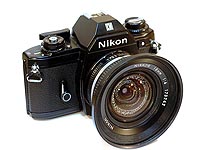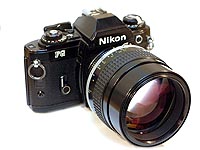
|
Tweet
Follow @sheldonbrowncom |

|
Tweet
Follow @sheldonbrowncom |
 Nikon SP with 21 mm Zeiss Biogon Wide Angle Lens |
 Nikon F with Vivitar 90-180 Zoom Lens |
 Nikon EM with Nikkor 18 mm f3.5 Lens |
 Nikon FG with Nikkor 105 mm f1.8 Lens |
|---|
I've owned a lot of Nikon cameras over the years, and have long been a major fan of the brand. Many of them have passed through my hands, and I still own quite a few of them.
This page is dedicated to Nikons past...
Before I owned a Nikon body, I was given a water-damaged Nikkor lens, 85 mm f 1.8, a great piece of glass. At the time I was still using the Miranda system, and there was an adaptor that would permit Nikon F mount lenses to be mounted onto the Miranda body.
My water job 85 had hopelessly wrecked diaphragm blades, but I was able to get the glass cleaned up and the focus to work, so I could use it wide open, and it was great for "available darkness" shooting.
Somewhat later, after acquiring a Nikkormat body, I was able to order a new set of diaphragm blades for it and restore it to full functionality.
This was my primary lens for bicycle racing photography, which I was pretty serious about in the late '70s.
A few years ago I gave this lens to my sister, and she still has it.
I don't recall where I bought the Nikkormat, but I gave it a lot of use. Those old Nikkormats were great cameras, and the all-metal Copal Square shutter was really superior to the cloth roller curtain shutters used on most contemporary SLRs.
This was my first auto-exposure camera, it worked very well but could be expensive to run. It used a costly 6 volt (PX28) silver-oxide battery, and it was all too easy to forget to turn it off, which would kill the battery in a few hours.
I used to service these, which was quite a challenge, because almost any repair required removal of the printed circuit that sat atop the pentaprism...as I recall, there were some 21 tiny wires to de-solder then re-solder on reassembly!
Our house was burglarized and the FE/MD12 were stolen. Homeowners insurance replaced it with the 2020. The 2020 has a built-in motor drive, and was also one of Nikon's first autofocus SLRs.
The autofocus was pretty useless, because it's realllllly sloooooow. However the camera is otherwise really nice, and it was a nice upgrade from the FE.
I liked this model so much that I later bought a second 2020. These were my main cameras until I went over to the digital Dark Side.
One of the 1.4s is a quite old one that I did a home-made AI conversion to.
The legendary Vivitar Series I "flat field" 90-180 zoom. The zoom range was never very impressive, but this is a very high perfomrance lens, intended mainly for macro use. It's big and heavy, and has a tripod mount built onto a collar near the middle of the lens.
The tripod mount turns out to be a super feature. When I was doing a lot of product photoghraphy in 35, this gave some of the versatility of a large format camera, because I could have a couple of bodies loaded with different emulsions, say one with Tri-x and another with Kodacrhome, and once I had a shot set up I could just switch from one body to the other, much as a large format camera changes backs.
The 1.8 combines this versatile focal length with enough speed to make it quite useful in low light situations. I bought this particularly for theatre/concert use, and have been quite well pleased with the results.
If you would like to make a link or bookmark to this page, the URL is:
https://sheldonbrown.com/org/cameras/nikons.html.